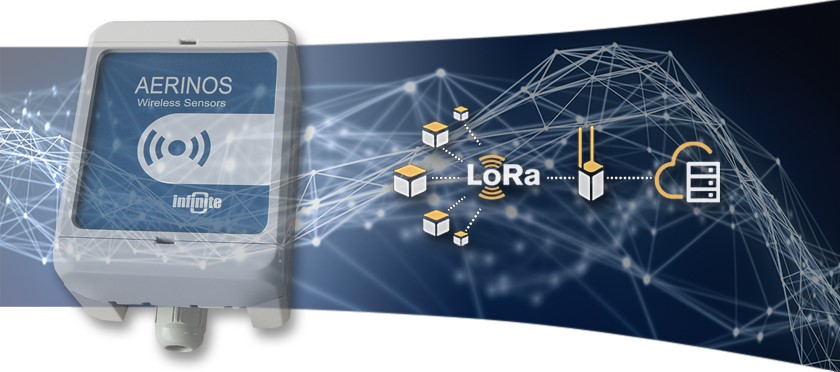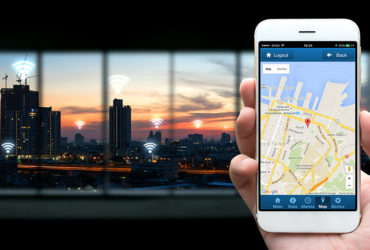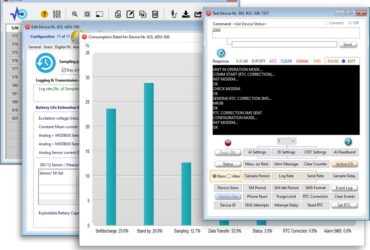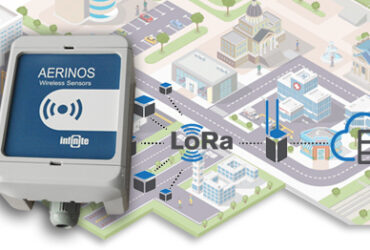
Introduction
ADS-270 is an ultra low power, battery powered end node for the LoRa network. The unit is available for the 433MHz, 868MHz and 915MHz bands. It incorporates two inputs, one digital with pulse counter capability and one analog, as well as multiple excitation options for powering transducers. A D-size Lithium Thionyl battery provides autonomous operation for over 10 years.
SDI-12 Serial Bus
SDI-12 is an asynchronous, ASCII, serial communications protocol that was developed for intelligent sensor instruments that typically monitor environmental, structural engineering and precision agriculture data. The communication is achieved by digital communications. The addressing system allows data recorder to communicate with several microprocessor-based sensors over a single line. ADS-270 is compliant to the SDI-12 Standard Version 1.2 and supports extended commands for sensor configuration, in terminal mode. ADS-270 can collect data from several SDI-12 sensors for a total amount of 8 measurement channels.
RS-485, MODBUS
ADS-270 supports acquisition from sensors with RS-485 interface, using the popular MODBUS protocol (RTU & ASCII). Up to 8 measurement channels from several sensors are supported.
Transducer excitation
The unit provides multiple excitation options for measuring transducers.
Applications
- Weather conditions & environmental monitoring
- Water/wastewater level & quality
- Structural engineering
- Precision Agriculture
- Smart City
- Oil & Gas
- Building Management
- Factory Automation
- Power Grid
Ordering Codes
| Code | Description |
|---|---|
| ADS-270-8 | LoraWAN end node, 868 MHz Band |
| ADS-270-9 | LoraWAN End node, 915 MHz Band |
| ADS-270-4 | LoraWAN End node, 433 MHz Band |
Specifications
| Power supply | |
|---|---|
| Supply voltage | Internal: 3.6V, 13Ah Lithium Thionyl battery (Saft LSH-20 recommended) External: 5 VDC, regulated |
| Consumption | |
| Stand by | 10μA max.at 3.6V |
| Communication | 868 MHz Band: Transmit: average 40mA, 915 MHz Band: Transmit: average 122mA, 433 MHz Band: Transmit: average 33mA. |
| Measurement | Up to 1A at 3.6V (according to sensor supply requirements) |
| Processing unit | |
| System controller | Ultra low power ARM 7 MCU |
| Configuration memory | 16 KByte EEPROM |
| Configurable Input (IN1) | |
| Digital input | 1, dry contact, 0-30VDC |
| Pulse counter | 1, 2KHz. |
| Analog input | 1, Range: 0-1V, 12 bit resolution. |
| Serial Bus features & options | |
| SDI-12 | 8 channels, up to 3 sensors, Support of extended commands in Terminal mode |
| RS-485, MODBUS | 8 channels, up to 3 sensors, MODBUS RTU & ASCII protocol |
| RS-485 | Sensors with RS-485 interface and proprietary protocol (OEM versions only) |
| Sensor excitation | |
| Output 1 | 12VDC/250mA |
| Output 2 | 5VDC/200mA |
| Communication | |
| 863-870 MHz Band | Uplink data rate (TX) up to 300Kbps with FSK modulation, Max output power +14dBm |
| 902-928 MHz Band | Uplink data rate (TX) up to 300Kbps with FSK modulation, Max output power +18.5 dBm |
| 433.050 MHz to 434.790 MHz Band | Uplink data rate (TX) up to 300Kbps with FSK modulation, Max output power +10 dBm |
| Transciever | 433 MHz Band & 868 MHz Band: RN2483 (Microchip), 915 MHz Band: RN2903 (Microchip) |
| Antenna connector | SMA Jack |
| Serial interface | USB, up to 115 kBit/s |
| Other | |
| Temperature | -40°…65°C, operating |
| Indications | LED, Operation status |
| Dimensions | 124 x 79.5 x 70 mm (with cable gland) |
| Protection | IP66, IP68 |
| Weight | 0.3 kg (without battery) |
| Document | File |
|---|---|
| ADS-270 Aerinos Sigfox Datasheet v1.x |
| Document | File |
|---|---|
| ADS-270 User Manual v1.x | |
| LSH-20, D-size, Lithium-thionyl battery | |
| WA Manager User Manual v10.x |
| Name | File |
|---|---|
| WA Manager configuration utility v10.67 |
Application Documents
| Name | File |
| How to build a LoRaWAN IoT telemetry application | |
| Presentation Autonomous RTUs | |
| Presentation IoT for Water Telemetry | |
| Presentation IoT for Precision Agriculture | |
| Presentation IoT for Structural Engineering & Rail Systems |
Latest News
Infinite partners with Losant
Infinite is proud to announce the partnership with Losant Enterprise …
Infinite releases new IOs and Android WaT applications v1.3.1
Infinite is proud to announce the release of a new …
Infinite releases WA Manager v:10.67
Infinite releases WA Manager v10.67. WA Manager is a Microsoft …
Infinite releases Aerinos ADS-270 LoRaWAN
Infinite releases ADS-270 LoRaWAN The unit is available for the …




